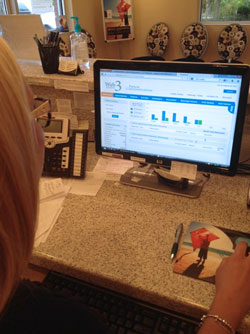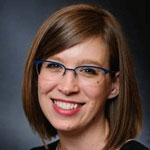Systems that ensure a smooth patient flow through your office allow more time for patients to shop in your optical dispensary.
Nobody likes to be kept waiting, least of all patients who are trying to squeeze in their doctor's appointment with other errands and responsibilities. From implementing new software systems to staff training and thinking carefully about our floor plan, there are ways to make hold-ups during office visits less likely. Here are some of the ways my practice keeps our office and patients' time with us flowing smoothly.
 |
|
Megan, the front desk team leader of Dr. Click's practice,
Preferred EyeCare Center in Mount Pleasant, SC, uses practice management system WebSystem3, a significant office efficiency booster.
|
The most important gain in efficiency we made this year was implementing WebSystem3 to handle our recalls and appointment confirmations. This has given the front desk much more time to concentrate on incoming phone calls, which has increased our shopper conversion rate.
Optimize Your Floor Plan
My office has a very open floor plan where the optical and front desk area is fairly close together. Sometimes people get confused on where to go for checking in, dispensing glasses, and checking out. When the office is at its peak busy times, there is a bottleneck of people trying to get all stages of the production cycle completed. This is one topic we discuss a lot during business meetings.
We recently reworked the way the front desk and optical complete the exam. We now have the check-out procedure include collecting all the co-pays and fees, along with scheduling the patient's next appointment. We used to have the optical collect fees and co-pays if glasses or contacts were ordered and then go to the front desk to check out by scheduling next year's appointment.
Discuss Efficient Work Flow in Staff Meetings
Fortunately, my practice is in a growth stage with new employees recently added. We are always talking about not only how we can make the office flow better now, but what potential issues we think may arise in the future. We always talk about our mission statement at every meeting. We are always critiquing ourselves for areas of improvement. A typical conversation starts off with asking the staff what they observed over the last week regarding how well we lived our mission or where we could have done better, including how to make the office flow more efficient and pleasant for patients.
Set Up System for Dealing with Very Late Patients
Whether a patient arrives early or late, we try our hardest to see the patient. I believe very strongly that if they took the time to show up, even if they are late, then they have a need to be seen. The only exception to this is the patient right before lunch or at the end of the day. We try to call our patients approximately 15 minutes after their appointment if they are late. If we are able to talk to someone this helps with our patient flow as we know if we are going to expect them or not.
It is important not to hold up other patients just because one patient came in 45 minutes late. If a patient shows up very late then we acknowledge how late they are and tell them we will have to work them in. We try to reassure them with a realistic time frame of how long their wait will be. If the patient gets upset or doesn't want to wait we ask them if they would rather reschedule to a time that is more convenient for them. When I see the patient in the exam room, I always thank them for their patience in allowing me to work them in. Most of the time I get an apology from them, but I think it creates good will to acknowledge these situations.
Create Efficient, Patient-Pleasing Office Operations: Action Plan
Be open to feedback whether it is from patients or staff. Sometimes the things that hurt to hear are the most helpful. You don't always realize things could be done in a more efficient manner until someone points it out to you. If a patient takes the time to write a negative comment in their post-visit survey, always respond with a personal e-mail acknowledging their complaint, apologizing and reassuring them that you will work to be more efficient in the immediate future.
Be open to change. Sometimes the things you do efficiently now might change with new staff or growth. For instance, with the addition of new staff or a new room or two at the office, you might find it possible to pre-test two patients at the same time. Try to have an attitude of gratitude. People who are late to their appointment still want to be seen or they wouldn't be there. I believe in acknowledging the tardiness, but you might not know what is going on in the patient's life that made them late. Be understanding and try your best to squeeze them in without inconveniencing other patients. |
EHRs Add to Efficiency
Electronic records are a necessity to keeping all aspects of the production cycle smooth. The great thing about an EHR is that everything is always in the same place and many modules within the system are auto-populated. Times still get busy and we all cut corners from time to time, but with an EHR, you don't have to worry about where the paper went and whoever helps to complete a job always knows where we left off.
In the exam module all the screens are set to normal (our default template) and I only have to change the abnormal findings. Also, if there is something abnormal I have the abnormal findings linked to diagnosis codes which speeds up billing. This not only allows me to complete the record faster, but the insurance can be billed instantly. The person who handles the insurance billing can submit the claim the same date of service. This makes the insurance claim process run more efficiently. Two things that I get good feedback on from patients is me being on time and my level of communication. Electronic medical records really help free up a few minutes.
Stay Conscious of Time in Exam Room
I am always very conscious of time, but I do let patients monopolize my time to an extent. We schedule our full exams every 30 minutes, which allows me to have about 15 minutes with each patient. Typically I don't need that much time, but it allows for me to have few extra minutes with each patient if needed. We book patients in blocks and then allow a 15-minute time slot that is not booked. For instance, we might see three new patients in a row and then have a 15-minute break. Or we could see four to five established patients and then have a 15-minute block of time to catch up, if needed. Not every patient wants to monopolize your time, so this scheduling method really works for us.
How Do YOU Keep Office Flow Moving Efficiently?
Rachael Click, OD, of Preferred EyeCare Center in Mount Pleasant, SC, asks for your feedback.
Related ROB Articles
Pre-Testing Revamp: Break Up Bottlenecks
Track Patient Time in Office: Do They Have Time to Shop?
Streamline Office Flow—and Leave Time for the Dispensary
 |












